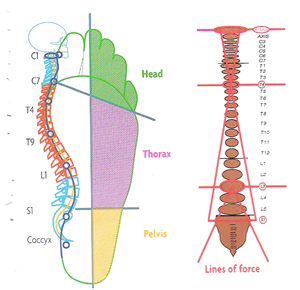Positive Health Online
Your Country

Treatment of Whiplash with Cranio-Sacral Reflexology
by Dr Martine Faure-Alderson(more info)
listed in reflexology, originally published in issue 167 - February 2010
Whiplash
A whiplash injury creates the same effect as a direct physical blow to the neck: this usually shows on x-rays between C4 and C5, or as a direct blow to the Sacrum, which settles on the lower part of the sacro-iliac and L5/S1.An animation of whiplash can be viewed on the following site:
http://www.spineuniverse.com/conditions/whiplash/whiplash-animation
The resulting reaction on the membrane covering the cord will be torsion and pull on one side or the other of the attachment at the top occiput-atlas-axis or at the bottom L5/S1/S2. This torsion from one end can easily adapt and travel to the other end of the spine, creating compression between bones of the skull or the face leading indirectly to depression or any other related symptoms or cranial nerves dysfunction.
Cranio sacral therapy produces excellent results in endogenous depression. This is the 'depression for no reason', where things just seem totally futile. There is no manic mood swing, but you just stay down in the dumps.
In this type of depression, we have found that there is compression in three places: the sacrum, in T4 and the base of the skull and SBS. It is such a consistent finding that we have named it the Compression/Depression Triad.

The cranio-sacral system is a 'core' system where the control mechanisms of body, mind, emotion and spirit all come together.
This explains why whiplash injuries can affect the Mental, Emotional and Physical human being.
An emotional shock or mental shock will end up with the same physical effect that a fall on the coccyx or fall on the occiput. Here we see the unity of the Mental, Emotional and Physical aspect of man interfering and influencing one level after another.

The Spinal Column and the
Inner Arch of the Foot
Anatomy of the Cranio-Sacral System
We have a 3-layer membrane system inside our body, which forms a waterproof bag around the brain and spinal cord.These three membranes are called the Dura Mater, The Pia Mater and the Arachnoid. They are known more commonly as the meninges. We consider this bag, its contents and these membranes as forming a semi-closed hydraulic system within our body, which functions as our 'core'.
Inside the membrane, we have the Cerebro-Spinal Fluid (CSF), which is rhythmically moving as long as we are alive. The Dura Mater attaches to the bones of the skull, lining inside the skull.
The skull bones must be in continual, minute motion in order to accommodate the constant fluid pressure changes that are going on within the membrane boundary of the semi-closed hydraulic system.
When skull bones lose their ability to move in response to the changing pressures of the cranio-sacral system, the function of this system becomes compromised and symptoms may occur.
As Cranio-Sacral therapists we know about the attachments of the dura mater membranes to the skull bones, to the vertebrae of the upper neck, to the sacrum in the low back, and to all the little openings in the skull and vertebral column that allow passage for major nerves going to all parts of the body. We know how to find the areas of restricted movement that compromise cranio-sacral system function.
In Reflexology we know to re-establish normal accommodation in all of these areas. In doing this work we are often able to improve the function of the nervous and endocrine system by improving the environment in which these systems do their work.
The Vagus nerve, which powerfully affects both stomach and bowel function (as well as having a big influence on heart rhythm and breathing), passes out of the base of the skull in a position that can easily be compromised by abnormal dura mater membrane tension.
If the bones have been jammed together by a blow on the forehead or on the back the head and have not been released, then this jamming or compression may eventually produce a similar compression at the base of the skull onto the neck and at the base of the lumbar spine onto the sacrum.
In the floor of the skull vault at the spheno-basilar symphysis, which is halfway between the two temples where two key bones, the occiput and the sphenoid meet, which is the location of this compression/torsion.
I have seen the compression at the lower end of the spine cause compressions at the other two sites. This usually happens as a result of a fall on the back or a blow to the head and the effect appears above or below the site of the injury approximately 21 days later.
Whiplash of Traumatic Origin
Road traffic accidents are not the only times when a whiplash can occur. It can happen with a great shock, a fall, a sudden break or a blow. This creates far-reaching changes in the tissue that occur during the rapid change from inertia to great speed, or the inverse. Even if the patient has forgotten the incident, the fascia records a memory of it within itself. Whiplash creates a disturbance of the Primary Respiratory Movement (PRM) and the resulting spasm of the fascia and dura mater traps the energy in the tissue. Symptoms can begin to appear a month later. Symptoms include migraine, vertigo, hearing problems, optic disturbances, back pain, insomnia, progressive fatigue, depression, memory loss, lack of concentration, dysmenorrhoea, uterine inertia, enuresis etc.
In many cases the victim is viewed by the health professionals to be malingering with imaginary symptoms. They will have x-rays, ECG, and appointments with a variety of specialists who cannot find a specific origin for their malaise. These patients are called hypochondriacs, and are told it is all in their heads. The insurance companies say they are being fraudulent, and there is nothing really wrong with them.
They are prescribed antidepressants, anti-anxiety medication and sleeping tablets which begin to create secondary effects.
Cranio-Sacral Reflexology and Osteopathy can bring great improvements and relief to these patients who have been traumatized by the spasm of the fascia and dura mater, especially with their supposedly imaginary symptoms.
Whiplash of Emotional Origin
Too many emotions – fear, arguments, and disagreeable thoughts – stimulate the cortex, and consequently create great agitation in the hypothalamus and pituitary glands. Under their command the adrenals flood the system with adrenaline and corticoids. That has a direct effect on the cardio-vascular, digestive, hormonal and musculo-skeletal system, the fascia, the Cranio-Sacral Fluid and therefore the PRM.Because the hypothalamus and the pituitary are situated near the centre of the cranio-sacral movement, being close to the SBS, and they are affected by the cranial movement, and importantly also have an effect on the CSR.
Other Causes of Whiplash
These can include vaccinations, epidural anaesthesia, x-rays, viral infections like flu and meningitis, watch batteries, mercury fillings, some heavy jewellery. They all disturb the PRM.Whiplash in Babies and Children
The disturbance of the PRM can cause any of the following symptoms in babies and children:- Crying without any specific cause
- Being asleep almost all the time
- Sleeping in one position or sleeping with the head in one position only;
- Nervousness or being agitated
- Clumsy or knocking themselves constantly
- Inability to suck or swallow
- Feet flopping in or out
- Scoliosis
- Pharyngitis and recurring otitis media
- Fearfulness or being withdrawn
- Aggressiveness or anger
- Too calm or very nervous
- Headaches
- Academic difficulties
- Mental slowness
The Principal Causes of these Lesions of PRM in Babies and Children
- Rapid or slow delivery
- Premature labour
- Narrow pelvis of the mother
- Presentation of the baby at delivery – obstetric procedures such as venture, forceps, epidural, caesarean section, multiple births, falls, accidents and vaccinations
Protocol for Treating Whiplash Injuries with Cranio-Sacral Reflexology
- SBS and sacrum +++
- Cranial sutures and cerebral trunk +++
- Hypothalamus, pituitary and adrenals ++
- Hormonal system ++
- Liver and kidney ++
- Solar plexus +
- Three tentorium: cerebellum, medium and sacrum +
By studying Cranio Sacral Reflexology, you will come to understand whiplash and its effects more clearly; as well as a host of other presenting conditions, whose aetiology is unknown.
Dr Sutherland urged his students: "the technical procedure I have advocated is anatomically sound, and has something specific to offer. You know your cranial anatomy. When you place your hands on this person's head [and feet] they must think, feel, see and know the anatomical picture that lies beneath them. Don't get away from that for an instant."
Further Information
To find out about courses in Cranio-Sacral Reflexology please visit http://www.positivehealth.com/course-list.php?subjectid=209
Comments:
-
No Article Comments available